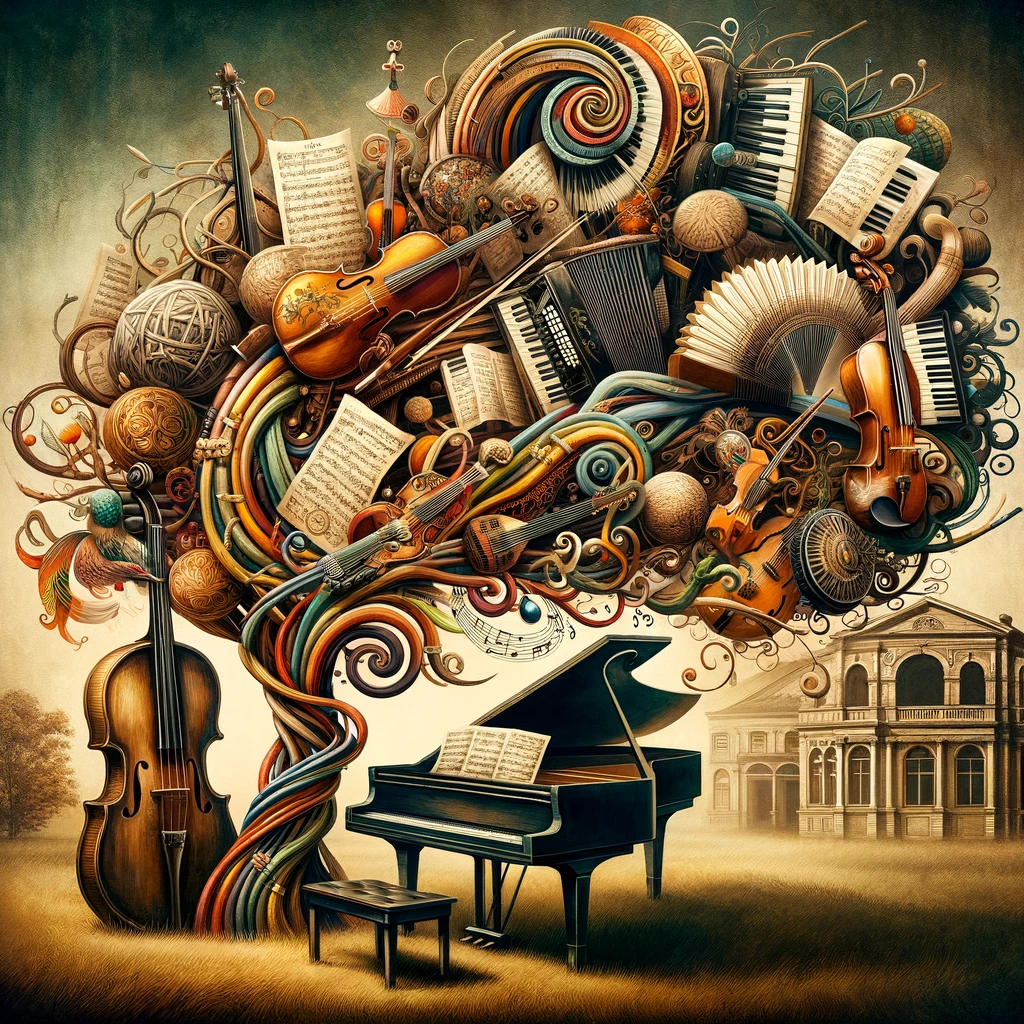
Beethoven: Folk Influences in His Timeless Works
Embracing the Melodies of the People
Ludwig van Beethoven, a name synonymous with classical music, was not just a prodigy who transcended musical norms, but also a maestro deeply influenced by the world around him. Among the myriad of elements that shaped his musical language, folk music played a pivotal role, offering a window into how societal and cultural factors intertwined with his personal and creative life.
Early Encounters with Folk
Beethoven’s journey into the world of music was as dramatic as some of his best symphonies. Born in 1770 in Bonn, Germany, his early life was a blend of rigorous training and challenging personal circumstances. His father, Johann, recognized his talent early but was a stern and often harsh instructor. Despite this, or perhaps because of it, young Ludwig developed a resilient character and an intense passion for music.
In these formative years, Beethoven was exposed to a variety of musical styles, but it was the folk songs and dances of the Germanic people that left an indelible mark on his compositions. Folk music, with its straightforward melodies and rhythmic vitality, offered a stark contrast to the formal and structured compositions of the classical period. It’s this blend of complexity and simplicity that later became a hallmark of Beethoven’s style.
Vienna and the Melting Pot of Cultures
At the age of 21, Beethoven moved to Vienna, the epicenter of classical music. Here, he studied with Joseph Haydn and encountered a melting pot of cultures, each with its unique folk traditions. Vienna was buzzing with Hungarian, Polish, and Bohemian influences, and Beethoven, with his insatiable curiosity, absorbed these diverse musical languages.
This exposure is evident in many of his compositions, where he seamlessly wove folk tunes into the fabric of classical forms. For instance, his “Six Variations on an Original Theme” in G Major, Op. 20, is a brilliant example of how he used a simple folk melody as the foundation for complex variations.
Personal Struggles and Folk Music as a Refuge
Beethoven’s personal life, marked by a series of misfortunes including the untimely death of his mother and his own debilitating hearing loss, greatly influenced his music. It was during these times of personal struggle that he often turned to the simplicity and comfort of folk music. The melodies were not just a source of inspiration but also a form of solace, a way to connect with the common man’s joys and sorrows.
His “Symphony No. 6 in F Major,” also known as the “Pastoral Symphony,” is a testament to this. In this symphony, Beethoven transports the listener to the countryside, with movements reflecting the serenity and storms of rural life. The symphony is replete with elements that mimic the sounds of nature, a characteristic often found in folk music.
The Political Climate and Folk Music’s Influence
The political upheavals of Beethoven’s time, including the French Revolution and the Napoleonic Wars, had a profound impact on Europe. These events echoed the themes of liberty, equality, and fraternity, resonating deeply with Beethoven. He saw folk music as the voice of the people, a means to express the collective sentiment of the time.
His “Symphony No. 9 in D Minor,” famously known for the “Ode to Joy,” is perhaps the best example of this. The symphony culminates in a choral movement that is both majestic and deeply human, a universal anthem of hope and brotherhood. The melody itself has the simplicity and appeal of a folk tune, yet is crafted with sophisticated musical mastery.
Fusion of the Classical and the Folk
What truly set Beethoven apart was his ability to fuse the classical with the folk. He didn’t just use folk tunes as themes for his compositions; he transformed them, embedding them within the classical structure in innovative ways. This fusion is evident in his string quartets and piano sonatas, where the spontaneity of folk music breathes life into the precise architecture of classical forms.
In pieces like the “Piano Sonata No. 17 in D Minor,” known as the “Tempest,” one can hear the echoes of folk rhythms and melodies, though they are transformed into something entirely new and emotionally profound.
The Legacy of Folk Influence in Beethoven’s Work
Beethoven’s use of folk music did more than just shape his own compositions; it paved the way for future generations of composers to explore and integrate folk elements into their work. His approach to folk music was not one of mere imitation but of deep respect and understanding, a way to connect the grandeur of classical music with the authenticity of the people’s voice.
This approach is particularly evident in his lesser-known works like the “Deutsche Tänze” (German Dances), where the rhythms and melodies are unmistakably folk-inspired, yet crafted with the hand of a master.

In understanding the full impact of folk music on Beethoven’s compositions, it is essential to delve into the specifics of how these influences manifested in his works and how they reflected his personal struggles and the zeitgeist of his era.
The Humanization of Classical Music
Beethoven’s affinity for folk music was part of a larger trend towards humanizing classical music, making it more accessible and emotionally resonant with the general public. His approach to composition, deeply influenced by folk themes, allowed him to break away from the rigid constraints of classical traditions. This was not only a musical revolution but also a cultural one, aligning with the broader European movement towards democracy and individual expression.
The “Eroica” Symphony: A Turning Point
A pivotal moment in Beethoven’s career that showcases the fusion of folk elements with classical music is his “Symphony No. 3 in E-flat Major,” also known as the “Eroica” Symphony. This groundbreaking work marked a significant departure from traditional symphonic form, not only in its scale but also in its use of melodies and rhythms that were reminiscent of folk music. The “Eroica” was a bold statement, reflecting both Beethoven’s personal struggles, particularly his realization of impending deafness, and his admiration for the democratic ideals sweeping Europe.
Folk Music as a Tool for Emotional Expression
The emotional depth of Beethoven’s music, often mirroring his personal challenges and triumphs, was amplified by his use of folk themes. These simple melodies provided an immediate emotional connection, something that resonated with listeners regardless of their musical training or background. In works like the “Piano Concerto No. 4 in G Major,” the use of folk-like melodies and rhythms creates an intimate, conversational tone between the piano and the orchestra, reflecting Beethoven’s deep desire for connection and understanding at a time when he was increasingly isolated by his hearing loss.
Beethoven’s Late Period: A Testament to Folk Inspirations
In Beethoven’s late period, his continued use of folk elements showcases a composer who, despite personal adversities, remained deeply connected to the human experience. Works from this period, like the “String Quartet No. 14 in C-sharp Minor,” exhibit a profound synthesis of folk simplicity and complex counterpoint, a reflection of Beethoven’s mastery in blending diverse musical elements.
This period of his life, marked by intense isolation due to his deafness, saw Beethoven turning inward, using music as a means of personal expression and communication. The folk influences in his late works are subtler but no less significant, offering glimpses of a man who, despite his genius, was grounded in the experiences and emotions of everyday life.
Folk Music and Beethoven’s Vision for the Future of Music
Beethoven’s integration of folk music into his compositions was more than a personal or stylistic choice; it was part of his vision for the future of music. He saw music as a universal language, one that could transcend social and cultural barriers. By incorporating folk elements, he not only broadened the appeal of his music but also laid the groundwork for future composers to explore the integration of local and cultural influences into classical music traditions.
This vision is evident in works like the “Seventh Symphony,” where the rhythms and themes have a folk-like, dance-like quality, yet are elevated to a level of sophistication and complexity that is unmistakably Beethoven.
Conclusion
Ludwig van Beethoven, through his revolutionary integration of folk music into classical compositions, achieved a timeless quality in his works. He managed to capture the essence of human experience, making his music relatable and moving across generations. His ability to transform simple folk melodies into profound musical statements is a testament to his genius. Beethoven’s music does not just speak to the elite or the educated; it speaks to the soul of every listener, echoing the universal joys and sorrows of humanity. In his compositions, the elegance of the concert hall meets the vibrancy of the village dance, creating a legacy that continues to inspire and move people around the world.